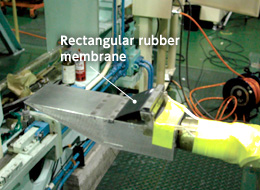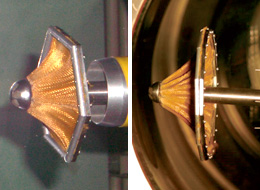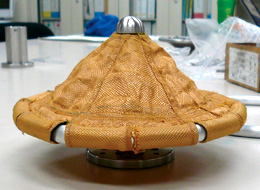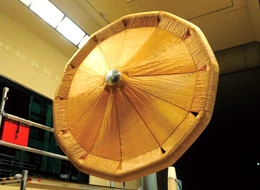TOP > Report & Column > The Forefront of Space Science > 2012 > Towards Realization of a Soft Atmospheric Entry Vehicle
![]()

The role of a wind tunnel in development As shown in Fig. 1, our flexible aeroshell is equipped with conically shaped thin membrane that surrounds the metal capsule in the center and acts as an aerodynamic decelerator. The shell's ring-shaped, external-frame structure sustains the aerodynamic force imposed on the membrane. In the flight experiment mentioned above, we verified the basics and proved that a flexible aeroshell of this shape could fly stably. Even so, we still had many hurdles to overcome if we hoped to build a vehicle capable of entering the atmosphere. Specifically, we had to answer these questions among others: Can our vehicle stand the aerodynamic heating occurring at entry to the atmosphere; Will our vehicle be destroyed by aerodynamic force; and Can our vehicle fly stably at a higher speed? The wind tunnel is the powerful tool to answer these questions. Since atmospheric-entry vehicles decelerate by aerodynamic force, it is very important to know accurately the aerodynamic force received during flight. Moreover, since they fly in a wide range of velocities, from ultrahigh-speed (8km/s) of orbital entry into the earth's atmosphere to low speed (7m/s) at descent just before landing, we needed to examine all of them. The range of speeds produced by a single wind tunnel is limited, so we used various wind tunnels to cover all the speed ranges and advanced our design by understanding properties in those ranges. The wind tunnels were used for other tests too. In a wind tunnel that can produce high-temperature airflow, we performed endurance tests of membrane materials against aerodynamic heating. Wind tunnels can be also used for strength tests. We were able to examine to what extent the aeroshell could stand aerodynamic force by applying wind to the shell. In the current design, we adopted an inflatable type for the outer frame to reduce weight. The inflatable type's shape is maintained by filling a membrane bag with gas. Put simply, it is like using a float for the outer frame. Recently, we have used a large wind tunnel to perform strength tests on a model equipped with 2.5m-diameter, float-type outer frame. As shown above, wind tunnel tests are indispensable to the development of flying vehicles. Fig. 2 shows some of the models used in wind-tunnel tests in the past.
|
||||||||||||||||||||||||||||||||||||||||||||||||||||||||||||||||||








